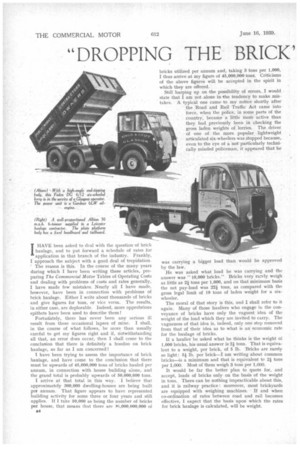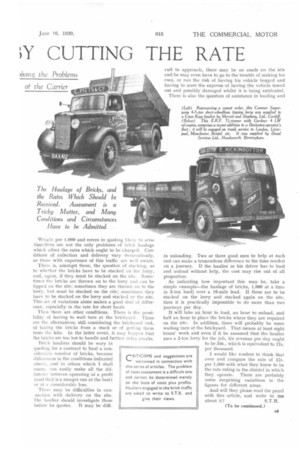"DROPPING THE BRICK' Y CUTTING THE RATE
Page 38

Page 39

If you've noticed an error in this article please click here to report it so we can fix it.
IHAVE been asked to deal with the question-of brick haulage, and to put forward a schedule of rates for application in that branch of the industry. Frankly, I approach the subject with a good deal of trepidation. ' The reason is this. In the course of the many years during which I have been writing these articles, preparing The Commercial Motor Tables of Operating Costs and dealing with problems of costs and rates generally, I have made few mistakes. Nearly all I have made, however, have been in connection with problems of brick haulage. Either I write about thousands of bricks and give figures for tons, or vice versa. The results, in either case, are deplorable. Indeed, more opprobrious epithets have been used to describe them!
Fortunately, there has never been any serious ill result from these occasional lapses of mine. I shall, in the course of what follows, be more than usually careful to get my figures right and if, notwithstanding all that, an error does occur, then I shall come to the conclusion that there is definitely a hoodoo on brick haulage, so far as I am concerned!
I have been trying to assess the importance of brick haulage, and have come to the conclusion that there must be upwards of 45,000,000 tons of bricks hauled per annum, in connection with house building alone, and the grand total is probably upwards of 50,000,000 tons.
I arrive at that total in this way. I believe that approximately 300,000 dwelling-houses are being built per annum. That figure appears to have represented building activity for some three or four years and still applies. If I take 50,000 as being the number of bricks per house, that means that there are "#,000,000,000 of 04 bricks utilized per annum and, taking 3 tons per 1,000, I thus arrive at my figure of 45,000,000 tons. Criticisms of the above figures will be accepted in the spirit in which they are offered.
Still harping up on the possibility of errors, I would state that I am not alone in the tendency to make mistakes. A typical one came to my notice shortly after the Road and Rail Traffic Act came into force, when the police, in some parts of the country, became a little more active than they had previously been in checking the gross laden weights of lorries. The driver of one of the more popular_ lightweight articulated six-wheelers was Stopped because, even to the eye of a not particularly techniCaIly minded policeman, it appeared that he was carrying a bigger load than would be approved by the law. He was asked what load he was carrying and the answer was " 10,000 bricks." Bricks very rarely weigh as little as 21 tons per 1,000, and on that minimum basis the net pay-load was 224 tons, as compared with the gross legal limit of 19 tons of laden weight for a sixwheeler.
The moral of that story is this, and I shall refer to it again. Many of those hauliers who engage in the conveyance of bricks have only the vaguest idea of the weight of the load which they are invited to carry. The vagueness of that idea is, indeed, only one step removed from that of their idea as to what is an economic rate for the haulage of bricks.
If a haulier be asked what he thinks is the weight of 1,000 bricks, his usual answer is 21 tons. That is equivalent to a weight, per brick, of 5 lb. Bricks are rarely so light : 54 lb. per brick—I am writing about common bricks—is a minimum and that is equivalent to 24 tons per 1,000. Most of them weigh 3 tons per 1,000.
It would be far the better plan to quote for, and accept, loads of bricks only on the basis of the weight in tons. There can be nothing impracticable about this, and it is railway practice : moreover, most brickyards are equipped with weighing machines. If and when co-ordination of rates between road and rail becomes effective, I expect that the basis upon which the rates for brick haulage is calculated, will be weight.
Weight per 1;000and •errors • in quoting likely to arise therefrom are not the only problems of brick haulage which affect the rates which ought to be charged. Conditions of collection and delivery vary tremendously, as those with experience of this traffic are well aware.
There is, amongst these, the question of stacking, as to whether the bricks have to be stacked on the lorry, and, again, if they must be stacked on the site. Sometimes the bricks are thrown on to the lorry and can be tipped on the site; sometimes they are thrown on to the lorry, but must be stacked on the site; sometimes they have to be stacked on the lorry and stacked cm, the site. This set of variations alone makes a good deal of difference, especially in the rate for short hauls.
Then there are other conditions. There is the possibility of having to wait turn at the brickyard. There are the alternatives, still considering the brickyard end, of taking the bricks from a stack or of getting them from the kiln. In the latter event, it may happen that the bricks are too hot to handle and further delay results.
cult to approach, there may be no roads on the site and be may even have to go to the trouble of making his own, or run the risk of having his vehicle bogged and having to meet the expense of having the vehicle towed out and possibly damaged whilst it is being extricated.
There is also the question of assistance in loading and in .unloading. Two or three good men to help at each end can make a tremendous difference to the time needed on a journey. If the haulier or his driver has to load and unload without help, the cost may rise out of all proportion.
As indicating how important this may be, take a simple example—the haulage of bricks, 1,000 at a time (a 3-ton load) over a 10-mile lead. If these are to be stacked on the lorry and stacked again on the site. then it is practically impossible to do more than two journeys per day.
It will take an hour to load, an hour to unload, and half an hour to place the bricks where they are required on the site. In addition, there will probably be some waiting turn at the brickyard. That means at least eight hours' work and even if it be assumed that the haulier uses a 2-ton lorry for the job, his revenue per day ought to be 34s., which is equivalent to 17s. per thousand.
I would like readers to think that over and compare the rate of 17s. per 1,000 with what they know to be the rate ruling in the district in which they operate. There are probably some surprising variations in the figures for different areas,
And will they please read the panel with this article, and write to me about it? S.T.R.




















































































